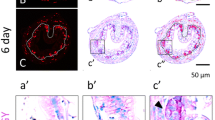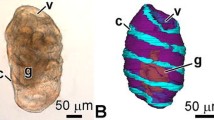Summary
Differentiation of the intestinal epithelium ofPleurodeles occurs during the last period of embryogenesis (stage 34) and is completed during the first stages of larval development before the onset of feeding (stage 37). In the course of this 4-day period the intestinal epithelium, which is a closed endodermal cylinder at stage 34, becomes a functional epithelium constituted by columnar absorbing cells and goblet cells. During intestinal differentiation, the cell number rises although the growth fraction decreases from 52% to 22%. At stage 34, mitoses are randomly distributed throughout the endoderm, but at stage 36 they become confined to cell nests which appear beneath the epithelium.
The cell nests correspond to the proliferating compartment which produces an equal number of dividing cells and of resting cells: these cells are arrested in the G1 phase of the generative cycle and differentiate. Such a pattern of proliferation and differentiation maintains a constant number of proliferating stem cells which subserve the renewing function in the intestinal epithelium after the onset of feeding. The relationships between cell proliferation and differentiation in the developing intestinal epithelium ofPleurodeles are closely similar to those observed in Mammals and suggest particularly that the intestinal cell nests of Urodela are analogous to the crypts of Lieberkühn in higher Vertebrates.
Résumé
Entre la fin du développement embryonnaire (stade 34) et le début de la vie larvaire (stade 37), l'épithélium intestinal du pleurodèle passe en 4 jours de l'état de cordon endodermique indifférencié à celui d'épithélium fonctionnel constitué de cellules absorbantes à plateau strié et de cellules à mucus. Au cours de cette différenciation, le nombre de cellules augmente de 2,6 fois environ bien que l'activité mitotique diminue régulièrement par abaissement du coefficient de prolifération de 52% à 22%. Les mitoses qui, dans le cordon endodermique au stade 34 sont uniformément distribuées, apparaissent brusquement localisées, au stade 36, dans les nids cellulaires sous-épithéliaux qui représentent dès lors la totalité du compartiment générateur intestinal. Avant même d'être localisé, ce compartiment produit autant de cellules qui, bloquées en phase G1 du cycle mitotique, cessent de se diviser et se différencient, que de cellules qui parcourent le cycle mitotique et se divisent à nouveau. Un tel processus laisse persister dans l'épithélium intestinal un nombre constant de cellules douées d'activité mitotique et capables d'assurer ainsi le renouvellement de ce tissu.
L'évolution de la prolifération et de la différenciation cellulaires dans l'intestin de pleurodèle est très comparable à celle observée chez les Mammifères et confirme, en particulier, l'analogie longtemps contestée entre les cryptes de Lieberkühn de ces derniers et les nids cellulaires sous-épithéliaux des Urodèles.
Similar content being viewed by others
Bibliographie
Brugal, G.: Relations entre la prolifération et la différenciation cellulaires: étude autoradiographique chez les embryons et les jeunes larves dePleurodeles waltlii Michah. (Amphibien, Urodèle). Develop. Biol.24, 301–321 (1971a)
Brugal, G.: Etude autoradiographique de l'influence de la température sur la prolifération cellulaire chez les embryons âgés dePleurodeles waltlii Michah. (Amphibien, Urodèle). Wilhelm Roux's Archiv.168, 205–225 (1971b)
Brugal, G.: Effects of adult intestine and liver extracts on the mitotic activity of corresponding embryonic tissues ofPleurodeles waltlii Michah. (Amphibia, Urodela). Cell Tissue Kinet.6, 519–524 (1973)
Brugal, G., Relations entre la prolifération et la différenciation cellulaires dans l'intestin embryonnaire et larvaire dePleurodeles waltlii Michah. II. Effets des chalones intestinales extraites de l'intestin de pleurodèle adulte. Wilhelm Roux's Archives,182, 147–163 (1977)
Brugal, G., Bertrandias, J.P.: Méthode mathématique d'évaluation du coefficient de prolifération dans les populations cellulaires embryonnaires en croissance exponentielle. C. R. Acad. Sci. Paris,270, 1603–1606 (1970)
Brugal, G., Chibon, P.: Signification des variations périodiques de l'indice de marquage en fonction du temps dans les tissus embryonnaires. C. R. Acad. Sci. Paris,270, 998–1001 (1970)
Brugal, G., Pelmont, J.: Présence, dans l'intestin du Triton adultePleurodeles waltlii Michah., de deux facteurs antimitotiques naturels (chalones) actifs sur la prolifération cellulaire de l'intestin embryonnaire. C.R. Acad. Sci. Paris,278, 2831–2834 (1974)
Brugal, G., Pelmont, J.: Existence of two chalone-like substances in intestinal extract from the adult newt, inhibiting embryonic intestinal cell proliferation. Cell Tissue Kinet.8, 171–187 (1975)
Bullough, W.S.: Mitotic and functional homeostasis: a speculative review. Cancer Res.25, 1683–1727 (1965)
Chibon, P.: Etude au moyen de la thymidine tritiée de la durée des cycles mitotiques dans la jeune larve dePleurodeles waltlii Michah. (Amphibien, Urodèle). C. R. Acad. Sci. Paris,267, 203–205 (1968)
Chibon, P., Brugal, G.: Durée de disponibilité de la thymidine exogène chez la larve et le jeune du tritonPleurodeles waltlii Michah. Annales Embryol. Morph.6, 81–92 (1973)
Dettlaff, T.A.: Cell division, duration of interkinetic states and differentiation in early stages of embryonic development.In: Advances in Morphogenesis (M. Abercrombie, J. Brachet, eds.),3, pp. 323–362. Academic Press, New York and London 1964
Dournon, C., Chibon, P.: Influence de la température, de l'âge et des conditions hormonales (thyroxine) sur la prolifération cellulaire chez la jeune larve et pendant la métamorphose du crapaudBufo Bufo L. (Amphibien Anoure). Wilhelm Roux's Archiv.175, 27–47 (1974)
Eastwood, G.L., Trier, J.S.: Epithelial cell proliferation during organogenesis of rat colon. Anat. Rec.179, 303–310 (1974)
Gallien, L., Durocher, M.: Table chronologique du développement dePleurodeles waltlii. Bull. Biol. Fr. et Belg.91, 97–114 (1957)
Graf, B., Bescol-Liversac, J.: Variation du coefficient mitotique et activité biochimique. Etude de la différenciation du parenchyme hépatique chez l'oie en période embryonnaire et après l'éclosion. Bull. Ass. Anatomistes.163, 877–884 (1974)
Gross, M., Goldwasser, E.: On the mechanism of erythropoietin induced differentiation. VII — The relationship between stimulated deoxyribonucleic acid synthesis and ribonucleic acid synthesis. J. biol. Chem.245, 1632–1636 (1970)
Hermos, J.A., Mathan, M., Trier, J.S.: DNA synthesis and proliferation by villous epithelial cells in fetal rats. J. Cell. Biol.50, 255–258 (1971)
Holtzer, H.: Mitosis and cell transformations. General physiology and cell specialization (D. Mazia, A. Tyler, eds.), pp. 80–90. McGraw-Hill Book Company, New York 1963
Holtzer, H., Weintraub, H., Mayne, R., Mochan, B.: The cell cycle, cell lineages and cell differentiation.In: Current Topics in Developmental Biology,7, pp. 229–256, Academic Press. New York and London 1972
Kitano, Y., Hu, F.: Proliferation and differentiation of pigment cellsin vitro. J. Invest. Dermatol.55, 444–451 (1970)
Leblond, C. P., Messier, B.: Renewal of chief and goblet cells in the small intestine as shown by radioautography after injection of thymidine-H3 into mice. Anat. Rec.132, 247–260 (1958)
Lipkin, M.: Proliferation and differentiation of gastrointestinal cells. Physiol. Rev.,53, 891–915 (1973)
Lipkin, M., Quastler, H.: Cell population kinetics in the colon of the mouse. J. Clin. Invest.41, 141–146 (1962)
Martin, R.: Etude autoradiographique du renouvellement intestinal de l'axolotl (Amphibien, Urodèle). C. R. Acad. Sci. Paris,272, 2816–2819 (1971)
Owens, I.S., Vonderhaar, B.K., Topper, Y.J.: Concerning the necessary coupling of development to proliferation of mouse mammary epithelial cells. J. Biol. Chem.248, 472–477 (1973)
Pardee, A.B.: A restriction point control of normal animal cell proliferation. Proc. nat. Acad. Sci. USA71, 1286–1290 (1974)
Patten, S.F.: Renewal of the intestinal epithelium of the Urodele. Exp. Cell Res20, 638–641 (1960)
Paul, J., Hunter, J.A.: DNA synthesis is essential for increased haemoglobin synthesis in response to erythropoietin. Nature (London)219, 1362–1363 (1968)
Quastler, H., Sherman, F.G.: Cell population kinetics in the intestinal epithelium of the mouse. Exp. Cell Res.17, 420–438 (1959)
Rott, N.N., Sheveleva, G.A.: Changes in the rate of cell divisions in the course of early development of diploïd haploïd loach embryos. J. Embryol. exp. Morphol.20, 141–150 (1968)
Ruch, J.V., Karcher-Djuricic, V.: Action de la 5-fluoro-déoxyuridine sur la différenciationin vitro de molaires d'embryons de souris. Arch. Biol.,82, 115–129 (1971)
Smart, I.H.M.: Proliferative characteristics of the ependymal layer during the early development of the spinal cord in the mouse. J. Anat.111, 365–380 (1972)
Stern, J.B., Dayton, L., Duecy, J.: The uptake of tritiated thymidine by the dorsal epidermis of the fetal and newborn rat. Anat. Rec.,170, 225–234 (1971)
Turkington, R.W., Topper, Y.J.: Androgen inhibition of mammary gland differentiationin vitro. Endocrinology.80, 329–336 (1967)
Vonderhaar, B.K., Topper, Y.J.: A role of the cell cycle in hormone-dependent differentiation. J. Cell Biol.63, 707–712 (1974)
Wessells, N.K.: Problems in the analysis of determination, mitosis, and differentiation. Epithelial-Mesenchymal Interactions. (R., Fleischmajer, R.E. Billingham, eds.), pp. 132–151. The Williams & Wilkins Company, Baltimore 1968
Author information
Authors and Affiliations
Additional information
Ce travail a bénéficié de l'aide du CNRS (ATP No A655 1799) et de l'INSERM (AT No 74 142036)
Rights and permissions
About this article
Cite this article
Brugal, G. Relations entre la prolifération et la différenciation cellulaires dans l'intestin embryonnaire et larvaire dePleurodeles waltlii Michah. Wilhelm Roux' Archiv 182, 131–146 (1977). https://doi.org/10.1007/BF00848053
Received:
Accepted:
Issue Date:
DOI: https://doi.org/10.1007/BF00848053




